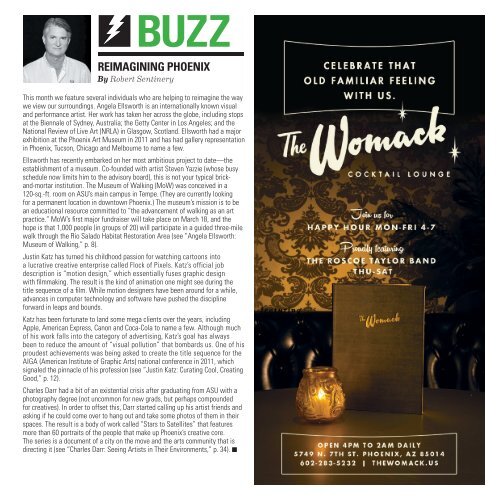Java.FEB.2017
You also want an ePaper? Increase the reach of your titles
YUMPU automatically turns print PDFs into web optimized ePapers that Google loves.
REIMAGINING PHOENIX<br />
By Robert Sentinery<br />
BUZZ<br />
This month we feature several individuals who are helping to reimagine the way<br />
we view our surroundings. Angela Ellsworth is an internationally known visual<br />
and performance artist. Her work has taken her across the globe, including stops<br />
at the Biennale of Sydney, Australia; the Getty Center in Los Angeles; and the<br />
National Review of Live Art (NRLA) in Glasgow, Scotland. Ellsworth had a major<br />
exhibition at the Phoenix Art Museum in 2011 and has had gallery representation<br />
in Phoenix, Tucson, Chicago and Melbourne to name a few.<br />
Ellsworth has recently embarked on her most ambitious project to date—the<br />
establishment of a museum. Co-founded with artist Steven Yazzie (whose busy<br />
schedule now limits him to the advisory board), this is not your typical brickand-mortar<br />
institution. The Museum of Walking (MoW) was conceived in a<br />
120-sq.-ft. room on ASU’s main campus in Tempe. (They are currently looking<br />
for a permanent location in downtown Phoenix.) The museum’s mission is to be<br />
an educational resource committed to “the advancement of walking as an art<br />
practice.” MoW’s first major fundraiser will take place on March 18, and the<br />
hope is that 1,000 people (in groups of 20) will participate in a guided three-mile<br />
walk through the Rio Salado Habitat Restoration Area (see “Angela Ellsworth:<br />
Museum of Walking,” p. 8).<br />
Justin Katz has turned his childhood passion for watching cartoons into<br />
a lucrative creative enterprise called Flock of Pixels. Katz’s official job<br />
description is “motion design,” which essentially fuses graphic design<br />
with filmmaking. The result is the kind of animation one might see during the<br />
title sequence of a film. While motion designers have been around for a while,<br />
advances in computer technology and software have pushed the discipline<br />
forward in leaps and bounds.<br />
Katz has been fortunate to land some mega clients over the years, including<br />
Apple, American Express, Canon and Coca-Cola to name a few. Although much<br />
of his work falls into the category of advertising, Katz’s goal has always<br />
been to reduce the amount of “visual pollution” that bombards us. One of his<br />
proudest achievements was being asked to create the title sequence for the<br />
AIGA (American Institute of Graphic Arts) national conference in 2011, which<br />
signaled the pinnacle of his profession (see “Justin Katz: Curating Cool, Creating<br />
Good,” p. 12).<br />
Charles Darr had a bit of an existential crisis after graduating from ASU with a<br />
photography degree (not uncommon for new grads, but perhaps compounded<br />
for creatives). In order to offset this, Darr started calling up his artist friends and<br />
asking if he could come over to hang out and take some photos of them in their<br />
spaces. The result is a body of work called “Stars to Satellites” that features<br />
more than 60 portraits of the people that make up Phoenix’s creative core.<br />
The series is a document of a city on the move and the arts community that is<br />
directing it (see “Charles Darr: Seeing Artists in Their Environments,” p. 34).


















